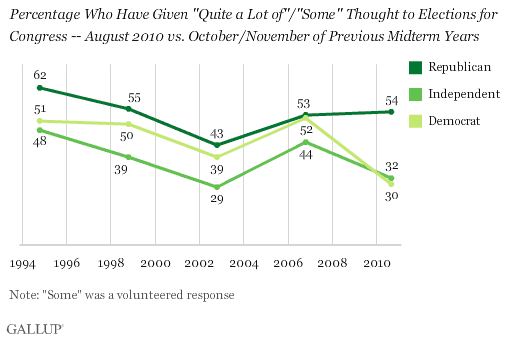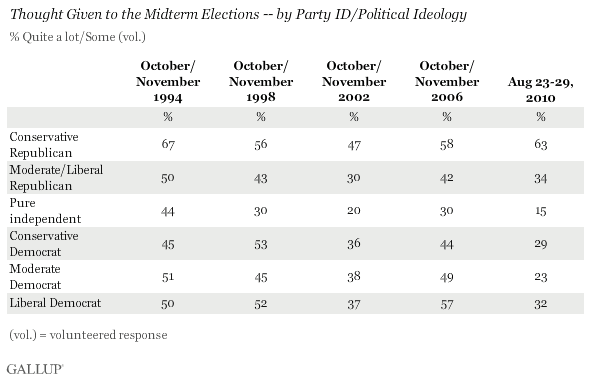PRINCETON, NJ -- Two months before this year's midterm congressional elections, Gallup finds 54% of Republicans, compared with 30% of Democrats, already saying they have given "quite a lot of" or "some" thought to the contests.

This "thought" measure is an important variable in Gallup's well-established classification of "likely voters," which is put into use closer to Election Day. The current gulf in thought between the parties mirrors the partisan gap in Gallup's voter enthusiasm measure that is tracked weekly.
Republicans' current level of thought about the elections, from Gallup Daily tracking conducted Aug. 23-29, matches or exceeds that found in October/November of the last three midterm years. By contrast, Democrats are giving far less thought to the elections today than they did in the final weeks before the prior four midterms. As a result, Democrats are on par with independents in current attention levels -- a sharp departure from recent years, when the Democrats exceeded independents on this measure.
The large party gap in "thought" suggests the typical Republican turnout advantage could be larger than usual this year if that gap persists until Election Day. Attention normally spikes as elections approach, and this is likely to occur among Democrats. However, it is unclear whether the Republicans have reached the limit for how much attention they will pay to a midterm election, or whether their attention will rise to perhaps a historic level by November. How this plays out will determine Democrats' ability to catch up to Republicans on this measure before Election Day, and will in turn determine the size of the Republican turnout advantage.
Conservative Republicans on High Alert
The extraordinary level of attention conservative Republicans (including Republican-leaning independents) are paying to the election is much of the reason Republicans' current attention dwarfs Democrats'. Sixty-three percent of conservative Republicans say they have given quite a lot of or some thought to the upcoming elections, roughly twice the proportion of moderate and liberal Republicans (34%), and liberal Democrats (32%).
Conservative Republicans were much closer to moderates and liberals of both parties on this measure in October/November of prior midterms. Also, only in 1994 did Gallup find a higher percentage of conservative Republicans paying quite a lot of or some attention to the elections than are doing so today. But with two months to go before the 2010 midterms, conservatives will likely match or exceed that record by Election Day.

Bottom Line
Gallup's "thought given to the elections" indicator of voter turnout suggests that, if the midterm elections were held today, the Republicans would have a substantial advantage over the Democrats in turnout -- largely because of the attentiveness of conservative Republicans. This would well exceed the typical turnout advantage Republicans enjoy in midterm elections, including 1994, when the GOP gained a historically large number of House seats.
It's a virtual certainty that voters' attention to the election will increase in the coming months. If this increase is proportionate between Republicans and Democrats, then the Republicans will likely maintain a formidable turnout advantage. However, it's also possible that Republicans have merely tuned in early to the elections, leaving less room for their attention to expand -- and thus giving the Democrats an opportunity to narrow the gap by November.
The latest results are based on telephone interviews conducted as part of Gallup Daily tracking Aug. 23-29, 2010, with a random sample of 7,075 adults, aged 18 and older, living in all 50 U.S. states and the District of Columbia, selected using random-digit-dial sampling.
For results based on the total sample of national adults one can say with 95% confidence that the maximum margin of sampling error is ±1 percentage point.
Interviews are conducted with respondents on landline telephones and cellular phones, with interviews conducted in Spanish for respondents who are primarily Spanish-speaking. Each daily sample includes a minimum quota of 150 cell phone respondents and 850 landline respondents, with additional minimum quotas among landline respondents for gender within region. Landline respondents are chosen at random within each household on the basis of which member had the most recent birthday.
Samples are weighted by gender, age, race, Hispanic ethnicity, education, region, adults in the household, cell phone-only status, cell phone-mostly status, and phone lines. Demographic weighting targets are based on the March 2009 Current Population Survey figures for the aged 18 and older non-institutionalized population living in U.S. telephone households. All reported margins of sampling error include the computed design effects for weighting and sample design.
In addition to sampling error, question wording and practical difficulties in conducting surveys can introduce error or bias into the findings of public opinion polls.
For more details on Gallup's polling methodology, visit www.gallup.com.
